
While the Kunming-Montreal Global Biodiversity Framework laid the groundwork at COP15, the task now in COP 16 is to ensure that these promises are backed by clear and actionable actions, as 200 countries that signed the agreement, to date, most countries are behind. According to an inform published by CarbonBrief last week, only 15 percent of countries, including Canada, have submitted nature pledges.
Nature Canada, one of the few ENGOs on Canada’s delegation at COP 16, explains in a communication the importance of “turning high-level agreements into measurable outcomes that halt and reverse biodiversity loss.” Although mining, forestry, and other extractive industries are part of the economy, their activities also jeopardize the natural world. So, for Nature Canada, the principal role at COP 16 is to ensure that nature does not get sidelined in favor of short-term economic gains.
The threat to the survival of plant and animal species is latent, and the statistics are alarming. According to a 2019 United Nations report, up to one million species are threatened with extinction, and more than half a million terrestrial species do not have sufficient habitat to survive in the long term. According to The Nature Conservancy, 17% of the land and 8% of our oceans are under designated protection. In Canada, more than 2,253 wild species are at risk of disappearing, according to the Wildlife Species 2020 report. Of that number, 105 exist in Canada alone, and 873 species are critically endangered. An article published by Radio Canada Internacional – CBC details which animals are in danger of extinction.
Canada’s Minister of Environment and Climate Change, Steven Guilbeault, delivered a statement on the opening day of COP16 in Colombia. He discussed what Canada has done after the COP15 agreements and what is expected in COP16.
"We have gone from one percent to 15 percent protected oceans. We have conserved almost half a million hectares of land, with many large-scale conservation projects in the works. We are upholding the Species at Risk Act to protect threatened species,” Guilbeault said.
During the speech, Guilbeault also mentioned that Canada has delivered its ambitious 2030 Nature Strategy, as promised at COP15, by proposing legislation to meet biodiversity commitments at the federal level. Besides, in 2023, Canada established the Nature Champions Network - a ministerial-level group that fosters international awareness and understanding of the global biodiversity framework.
In addition, Guilbeault spoke of the commitment to protecting 30 percent of Canadian land and water by 2030 and contributing $200 million to the Global Biodiversity Framework Fund launched in record time in 2023 to support developing countries in implementing their biodiversity plans to restore nature and grow resilient economies.
The statement also highlighted how crucial it is for Canada to strengthen engagement with Indigenous peoples. To carry this out, Canada is hosting multiple side events at COP16, including two in partnership with Indigenous Leadership Innovation. Besides, Guilbeault said the Government of Canada has invested in Indigenous-led conservation projects through initiatives like the Indigenous Guardians Program.
However, in an article titled COP16 en Colombia: se insta a los países a cumplir los compromisos de Montreal, published by Radio Canada Internacional – CBC, on October 28, West Coast Environmental Law’s lawyer, Anna Johnston, said in a blog: “Although Canada’s nature strategy for 2030 is a positive step, it is unclear whether it will be enough to stop, let alone reverse, the loss of nature.”
During the summit's opening ceremony on Sunday, Colombian Minister of the Environment and President of COP16 Susana Muhamad said: "We have to establish a principle of peace with nature, which also means the search for peace among peoples."
At COP16 Colombia, a conference from October 21 to November 1, delegates from different countries will continue to evaluate progress and present solid actions to protect biodiversity by conserving and safeguarding life on Earth.

Be the first to comment